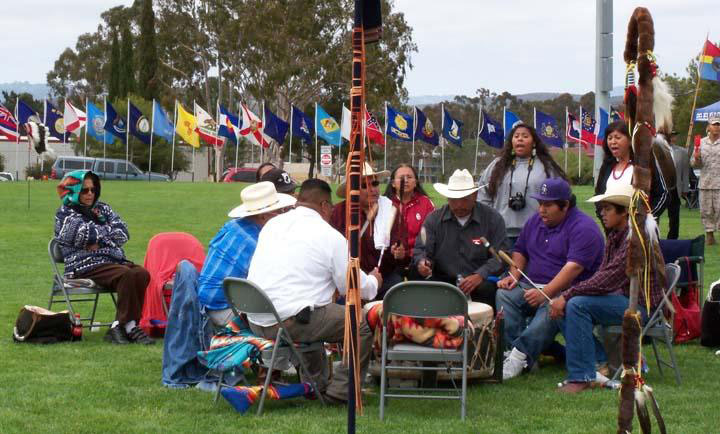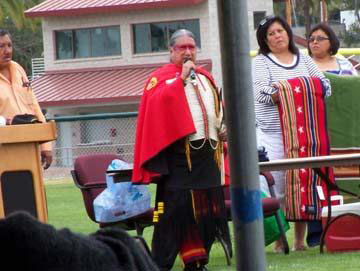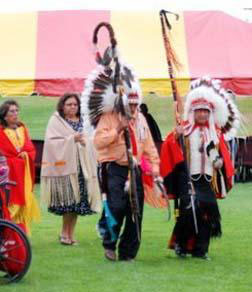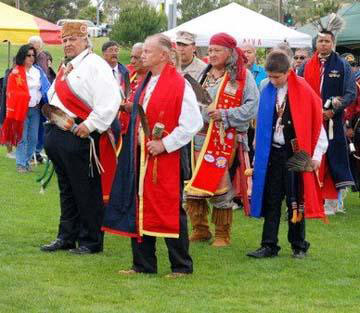NDN
Warriors at Kiowa Gourd dance on USMC Camp Pendleton
By Roy Cook

On Friday, June 15,
2012 from 2-8pm, Active duty Native Americans, USMC dignitaries and the
Gourd dance societies of California were invited to honor and recognize
our Warriors yesterday and today. The location was a lush green field
with shades and comfortable seating for the guests. The weather was not
a sunny Southern California postcard setting. Overcast 'Coastal Eddy'
was in and kept the sun hidden all day. But the songs were hot and kept
the dancers comfortable most of the day.

Rocky Chavez, retired USMC Coronel, was the featured speaker of the day. Alvin Rough Face of the Ponca Tribe was the Emcee, Daron Henson of the Cherokee Tribe was the Head Gourd dancer, Mary Lou Stevenson-Tselee of the Wichita Tribe was the Head Women Dancer and David Patterson of the Sac and Fox and Kickapoo Tribes was the Arena director. Many were Marine veterans and some Hollywood celebrities. Once a Marine, always a Marine. In addition to the principals also recognized and Honored Serviceman is: Kevin Zotigh of the Kiowa Tribe and a Navy corpsman with the Marines.
Additionally, the
Honored Veteran is Earl Steen of the Muscogee Creek Tribe, US Navy 1957-1960.
Our national debt to past Veterans from other conflicts that came home
to no respect, no fanfare or appreciation was recalled and they were thanked
for their service at this event. In Indian country, our returning Warriors,
female and men, have always been publically acknowledged for their service
to this land and their Tribe. The Emcee, Alvin Rough Face said, “Things
are changing, Women make the supreme sacrifice like men.”
Steve Bohay, President of the Golden State Gourd Society, GSGS, related
the background of the organization. He also recognized Charter member
and past President of the GSGS, Randy Edmonds. A number of the GSGS members
were present including the Honored Veteran, Earl Steen. Of special note,
Black Leggings Society lances and Tia-Piah feather bonnets bracketed the
singers and songs of the gourd dance.

The name, Black Leggings,
remained the name of the society even though they became one of the best
'horse mounted forces' on the Plains. Some say it was because the dust
from the trail made their legs black. This was before there were horses.
Others say it was because their legs were blackened while running back
into action after an enemy thought they had burned out an area to repel
an attack. Society officers also want to keep the regalia as authentic
as possible. A black string shawl is worn on the waist, from the knees
down the legs are black with paint or leggings, a decorated lance or  spear
is carried and the red cape is draped over their shoulders. A red cape
must be worn to honor one of the Ton-Kon-Gah chiefs. Gool-Hay-Ee (Young
Red Colt) killed a Mexican officer and took his red cape as a war trophy.
The society is still in possession of the original cape.
spear
is carried and the red cape is draped over their shoulders. A red cape
must be worn to honor one of the Ton-Kon-Gah chiefs. Gool-Hay-Ee (Young
Red Colt) killed a Mexican officer and took his red cape as a war trophy.
The society is still in possession of the original cape.
It felt just right
to enjoy a day of down home Gourd Dancing with fellow veterans from many
conflicts and tribes. There were multiple sessions of dancing and specials
for those honored with responsible positions at the event.
A Kiowa story recounts the tale of a young man who had been separated
from the rest of the tribe. Hungry and dehydrated after many days of travel,
the young man approached a hill and heard an unusual kind of singing coming
from the other side. There he saw a red wolf singing and dancing on its
hind legs. The man listened to the songs all afternoon and through the
night and when morning came, the wolf spoke to him and told him to take
the dance and songs back to the Kiowa people. The "howl" at
the end of each gourd dance song is a tribute to the red wolf. The Kiowa
Gourd Dance was once part of the Kiowa Sun Dance ceremony.
 Other
tribes including the Comanche and Cheyenne also have traditions about
the gourd dance. The Cheyenne believe that the Cheyenne tribe is the source
of the gourd dance and have elaborate oral tradition accounting for it.
The modern gourd dance does indicate Kiowa influence pertaining both to
the social etiquette and especially the songs. In the Southern Plains
the gourd dance is dominated by Kiowa presence.
Other
tribes including the Comanche and Cheyenne also have traditions about
the gourd dance. The Cheyenne believe that the Cheyenne tribe is the source
of the gourd dance and have elaborate oral tradition accounting for it.
The modern gourd dance does indicate Kiowa influence pertaining both to
the social etiquette and especially the songs. In the Southern Plains
the gourd dance is dominated by Kiowa presence.
Additionally, at this event, there was very special recognition of two of the warrior societies off the Kiowa: Black legging and Tia-Piah. The variations on the word "Tia-Piah" used in the names of Kiowa Gourd Dance organizations come from Jài:fè:gàu (Tdeinpei-gah), one of the eight Kiowa warrior societies. Perhaps because of the military connotations of the term the Gourd Dance has often been mistaken for a "veteran's dance". However, leaders of all three of the earliest Kiowa-established gourd dance organizations agree that this is not a requirement to become a member of the societies.

As the first sessions
of the gourd dance were ending the chill ocean breeze sharpened the appetites.
The base provided a fine dinner menu for all to enjoy: Corn soup, chicken,
many salads, fry bread, fried rice, many selections of desert and good
sweet watermelon. Beverages included coffee, bottled water or your choice.
The meal nourished the body and warmed the spirit.

In the last sessions
of the Gourd dance for the overcast day the tempo of the songs increased.
The Kiowa name for this dance is 'Tsat-Koie-Gya' or Encountering the Enemy.
The dance, which is actually a rite, is a re-enactment of a battle that
occurred in the early 1800s. In this warm hopeful spirit, the 2012 USMC
Kiowa Gourd dance came to a fine finish with good thoughts and many happy
words with good friends from many years and places. Maybe we will see
each other at the next Indian doing or next year for this Gourd dance
event.